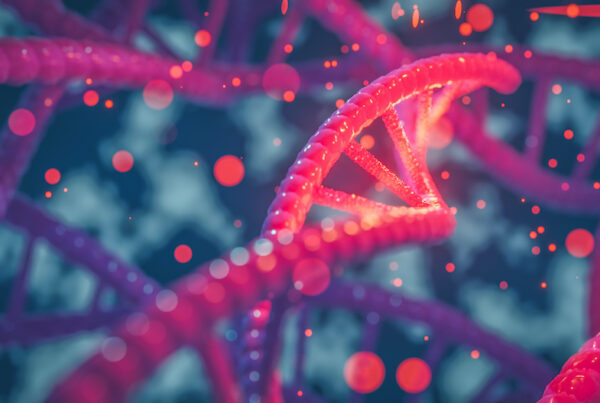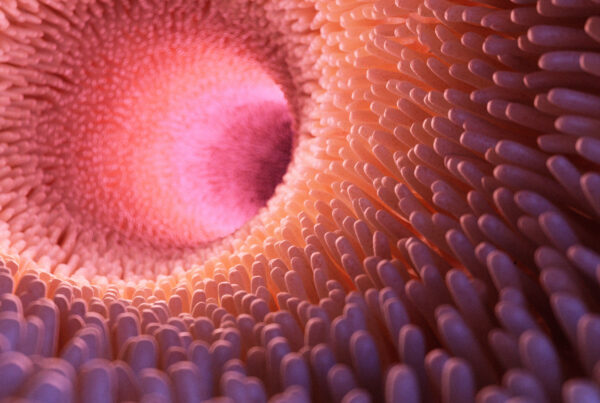Even the most basic biological processes in the human body are the result of an interdependent series of sophisticated cellular triggers and responses. Hormones like testosterone, estrogen, and human growth hormone (HGH) are well known due to the critical functions they help to carry out in the body, from growth and development to sexual reproduction and well-being.
But even the simple act of secreting a hormone like HGH from the pituitary gland and into the bloodstream requires the help of additional chemical agents to help kick off the chain reaction.
GHRH, GHRP, and the Role Secretagogues Play in the Endocrine System
The human endocrine system consists of multiple glands that secrete the hormones responsible for a range of functions, from growth and development to the body’s metabolism. The network of endocrine glands includes:
- Pituitary gland
- Thyroid gland
- Parathyroid gland
- Thymus
- Adrenal glands
- Pancreas
- Ovaries
- Testes
In order to function properly, the endocrine system works in harmony with the nervous system to send the brain the information it needs to initiate a specific function and trigger the release of hormones or electrical signals as needed. The endocrine system is connected to the brain and nervous system through the hypothalamus, and overall endocrine function is funneled through the pituitary gland, which is connected to the hypothalamus and controls the rest of the glands in the endocrine system.
The pituitary gland secretes a number of important hormones including:
- GH (growth hormone) – primarily responsible for growth and development, as well as protein production and bodily fat distribution
- ACTH (adrenocorticotropic hormone), LH (luteinizing hormone), FSH (follicle-stimulating hormone) – regulate sex hormones, responsible for estrogen, testosterone, egg, and sperm production in reproductive age women and men
- Oxytocin – regulates uterine contraction and milk ducts in female breast tissue
- Prolactin – triggers milk production in breasts
- Vasopressin – regulates blood pressure and water retention in kidneys
- TSH (thyroid-stimulating hormone) – produces thyroid hormone which controls metabolism, growth, puberty, and nervous system development
Hormone production is turned on and off in the hypothalamus to keep the body in balance (homeostasis), and to ensure that the hormones are only produced when they’re needed. Depending on their function, the production of certain hormones plummets and tapers off as people get older.
What are Secretagogues?
A secretagogue is an agent that induces the release (secretion) of a substance, such as hormones and chemicals from the glands or organs like the stomach. A prime example of a secretagogue at work is in people with type 1 diabetes, where the pancreas doesn’t produce enough insulin on its own. Insulin secretagogues are prescribed to diabetic patients to help stimulate insulin production in the pancreas.
Insulin is just one example. Secretagogues help to stimulate everything from saliva production to growth hormone in the human body.
 GHRH (Growth Hormone Releasing Hormone)
GHRH (Growth Hormone Releasing Hormone)
In order to maintain the right chemical balance and cellular function throughout the body, the glands have to release hormones at the right time. They also need a way to shut the valve off when the hormone has performed its function to prevent the glands from secreting too much of a hormone or at the wrong time. In order to “turn on” or trigger the release of primary hormones like growth hormone, the hypothalamus produces additional chemical messengers known as releasing hormones.
As its name implies, GHRH helps to regulate the circulation of growth hormone. According to the Society for Endocrinology:
“Growth hormone-releasing hormone is a hormone produced in the hypothalamus. The main role of growth hormone-releasing hormone is to stimulate the pituitary gland to produce and release growth hormone into the bloodstream. This then acts on virtually every tissue of the body to control metabolism and growth. Growth hormone stimulates production of insulin-like growth factor 1in the liver and other organs, and this acts on tissues in the body to control metabolism and growth. In addition to its effect on growth hormone secretion, growth hormone-releasing hormone also affects sleep, food intake and memory.
The action of growth hormone-releasing hormone on the pituitary gland is counteracted by somatostatin, a hormone also produced by the hypothalamus, which prevents growth hormone release…In order to maintain a normal balanced hormone production, growth hormone-releasing hormone, somatostatin, growth hormone and insulin-like growth factor 1 levels are regulated by each other.
The consequence of growth hormone-releasing hormone action is an increase in the circulating levels of growth hormone and insulin-like growth factor 1 which, in turn, act back on the hypothalamus to prevent growth hormone-releasing hormone production and to stimulate somatostatin secretion. Somatostatin then prevents the release of growth hormone from the pituitary gland and growth hormone-releasing hormone production by the hypothalamus, therefore acting as a powerful suppressor of growth hormone secretion.
Many other factors and physiological conditions such as sleep, stress, exercise and food intake also affect the hypothalamic release of growth hormone-releasing hormone and somatostatin. In adults, the most important consequences of reduced growth hormone levels are changes in body structure (decreased muscle and bone mass and increased body fat), tiredness, being less lively and a poor health-related quality of life.”
As we age, the body’s production of growth hormone declines considerably, leading to loss of lean muscle mass, increased abdominal and body fat, and decreased strength.
Peptide therapy treatments like CJC 1295 without DAC (also referred to as GRF 1-29) in combination with ipamorelin (which is a GHRP) help stimulate natural growth hormone production in the body in an effort to counteract some of the side effects of less growth hormone and the aging process.
How Growth Hormone Releasing Hormone Works
It’s easy to get the function of GHRHs and GHRPs confused. To put it simply, GHRHs (growth hormone-releasing hormone) function by stimulating the pituitary gland to produce and release growth hormones into the bloodstream. GHRPs (growth hormone releasing peptide), on the other hand, stimulate the body to release growth hormone at higher, more youthful frequency. Ideally, you want GHRHs to signal for your body to produce growth hormone, and you want a GHRP to encourage your body to release those growth hormones in a large pulse.
By themselves, GHRHs can have numerous beneficial effects on the body. They can downregulate the body’s inflammatory response, assist in wound healing, improve immune system function, and help the body maintain glucose homeostasis.
While numerous GHRHs exist, the two we’ll focus on are CJC 1295 (specifically GRF 1-29) and tesamorelin.
CJC 1295 (Without DAC) / GRF 1-29
Depending on where you’re looking, you’ll either see this GHRH referred to as CJC 1295 Without DAC or as GRF 1-29. It’s important to understand that they are both the same thing.
CJC 1295 increases levels of growth hormone in the blood, as well as insulin-like growth factor 1 (IFG-1).
While we won’t get too deep into it within this article, “DAC” stands for drug affinity complex, and while some claim that it increases CJC 1295’s effects, we do not recommend using it for safety reasons.
Tesamorelin
Tesamorelin was specifically developed to help reduce abdominal fat in patients with HIV. Some HIV treatments can cause lipodystrophy, which is a metabolic condition that causes uneven fat distribution, insulin resistance, and hyperlipidemia.
Tesamorelin is very effective, but difficult to acquire due to a handful of complicated reasons.
GHRP (Growth Hormone Releasing Peptide)
As mentioned previously, GHRPs work by stimulating the body to increase the pulse frequency of growth hormone release. GHRPs work by stimulating the body in the same way that ghrelin does.
According to the Society for Endocrinology:
“Ghrelin is a hormone that is produced and released mainly by the stomach with small amounts also released by the small intestine, pancreas and brain.
Ghrelin has numerous functions. It is termed the ‘hunger hormone’ because it stimulates appetite, increases food intake and promotes fat storage. When administered to humans, ghrelin increases food intake by up to 30%; it circulates in the bloodstream and acts at the hypothalamus, an area of the brain crucial in the control of appetite. Ghrelin has also been shown to act on regions of the brain involved in reward processing such as the amygdala.
Ghrelin also stimulates the release of growth hormone from the pituitary gland, which, unlike ghrelin itself, breaks down fat tissue and causes the build-up of muscle.
Ghrelin also has protective effects on the cardiovascular system and plays a role in the control of insulin release.”
Despite its primary role as a “gut” hormone, ghrelin also plays a hand in stimulating the release of growth hormone and some of the functions associated with growth hormone in the body including but not limited to:
- Preventing muscle atrophy
- Muscle differentiation and fusion
- Bone formation
- Metabolism
According to the findings of a study published in the Journal of Neuroendocrinology:
“Orexigenic peptide ghrelin and its receptor have been extensively investigated as potential therapeutic targets, primarily because of their role in feeding initiation and growth hormone (GH) release. However, no specific ghrelin targeting anti‐obesity or cachexia therapeutics are available for clinical use thus far and further efforts in this direction are warranted.
The present study aimed to find new peptide drug leads modulating ghrelin signal transduction. By targeting neutralising antibodies against ghrelin with phage display libraries, we aimed to identify peptides binding to the cognate receptor. Four synthetic peptides were selected and tested using calcium screening assays. The most effective competitive antagonist FSFLPPE was further tested in vivo.
Administration of the peptide produced no significant effect on either food intake or GH release. Surprisingly, when co‐administered with ghrelin, the peptide significantly enhanced GH secretion and c‐Fos expression. The evidence obtained in the present study indicates that FSFLPPE might act as an ago‐allosteric modulator.”
While it is not necessarily a GHRP, one non-peptide ghrelin-receptor agonist that is worth mentioning is MK-677. You can find our ultimate guide on MK-677 here.
Some common GHRPs include:
GHRP-6
GHRP-6 was one of the first hexapeptides to be studied in humans. GHRP-6 is known for being potent, but also for dramatically increasing appetite.
GHRP-2 (Pralmorelin)
GHRP-2 is a growth hormone secretagogue that is used primarily as a diagnostic agent. It acts as a ghrelin agonist and was the first of its kind to be introduced to the clinical market.
Ipamorelin
Ipamorelin is the GHRP we suggest for most of our clients. Like the other GHRPs on this list, it naturally stimulates the body to increase the pulse frequency of growth hormone release. It does this without the increased hunger of GHRP-6. It also increases nitrogen retention and has demonstrated good safety and tolerability in humans. It also does not create prolactin or cortisol.
 Combination CJC 1295 and Ipamorelin Therapy
Combination CJC 1295 and Ipamorelin Therapy
Rather than mimicking the growth hormone itself, peptide therapies like CJC 1295/GRF 1-29 and ipamorelin work like secretagogues to stimulate the pituitary gland’s production of growth hormone on its own.
Because of the synergistic way GHRHs and GHRPs interact, it’s generally a good idea for CJC 1295/GRF 1-29 and ipamorelin to be given together.
We’re so passionate about this that we wrote an entire blog post about it.
Injectable Peptide Therapy
There are several forms of hormone therapies, but peptide therapy is based on the science of endocrinology to help enhance wellbeing and health following the body’s existing roadmap. Injectable peptides are typically most effective because they bypass the process of digestion, where peptide chains are usually broken down into their individual amino acid components before they reach the bloodstream.
Healthy and active adults that wish to optimize their physical strength and performance, and to help mitigate some of the side effects that naturally develop as a result of the aging process typically make good candidates for peptide therapy. Depending on your individual health profile and goals, we offer several types of peptide therapy to help with everything from muscle recovery and sexual health to better sleep. Consult with your physician or healthcare provider to find out if peptide therapy is safe for you.
For more information about CJC 1295 (GRF 1-29), ipamorelin, and peptide therapy, contact us today to discuss your goals and to learn more about our products and services.
As with any treatment, the results and potential side effects of peptide therapy will vary from person to person. Peptide therapy is not intended as a replacement or alternative to medical treatment or a healthy diet and active lifestyle, which is the cornerstone of lasting health, wellbeing, and longevity. For high functioning and athletic individuals, peptide therapy may provide an added boost to traditional therapies and treatment programs.


 GHRH (Growth Hormone Releasing Hormone)
GHRH (Growth Hormone Releasing Hormone) Combination CJC 1295 and Ipamorelin Therapy
Combination CJC 1295 and Ipamorelin Therapy

